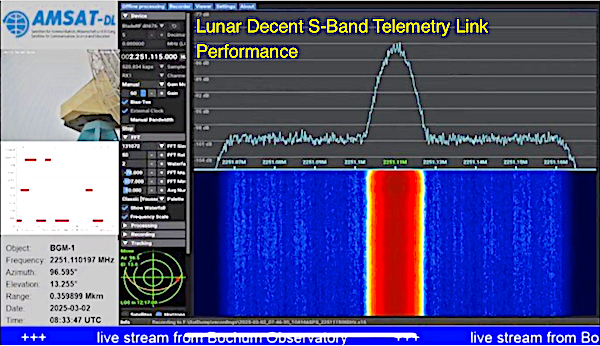

Vulcan Wireless assists the United States returning to the Moon after 52 years! Vulcan Wireless played a critical role in the successful lunar landing and operation of Blue Ghost Mission 1 lander, providing advanced communication systems that enabled high-data-rate transmissions from the lunar surface.
The Blue Ghost Lander relied on Vulcan Wireless’s S-Band transponder, X-Band transceiver, and three S-Band antennas to establish robust and efficient communications throughout the mission. The S-Band communications subsystems used two distinct waveforms to ensure reliable connectivity throughout the mission.

During orbital and cislunar commissioning, the lander utilized CCSDS standard PN ranging waveform, which provided highly precise Doppler and range measurements, exceeding system requirements of 10-meter RMS range accuracy and Doppler accuracy. As the mission transitioned to autonomous landing, Firefly Aerospace selected the CCSDS telemetry standards-based waveform for its higher data rate capabilities for monitoring real time telemetry.
To enable high-bandwidth communications, the X-band transmitter implements the CCSDS DVB-S2 standard, which is optimized for maximum throughput and spectral efficiency in high-data-rate transmissions. This waveform is specifically designed for high-resolution imaging and large data file transfers to Earth. An example of this application is illustrated in the following figure.

Vulcan Wireless’ S-Band radio, coupled with three of Vulcan’s high-performance broad-beam unified S-Band antennas, provided all-aspect communications for the lander, ensuring uninterrupted data transmission throughout the mission. It also provided all range and velocity measurements to support accurate navigation to the moon and it’s decent to the surface.During cislunar operations the team demonstrated high power X-Band 10 Mbps data rates using the DVB-S2 waveform, and the system is now successfully transmitting this from the lunar surface — which sets a new record data rate from the Moon.
The mission’s success has been widely recognized across the space communications community. AMSAT-DL described the downlink signal as “the smoothest and most stable communications link [they] have ever observed.” ASI, a key partner in the mission, confirmed that the “S-Band was rock solid all the way down to the surface, and X-Band is now sending data at 6 Mbps from the lunar surface.” In response, Vulcan Wireless President/CEO stated, “this is the best professional compliment Vulcan Wireless could receive”. The following screenshot shows the observation from the 20-meter AMSAT-DL ground terminal during the 3/2/25 landing.

Blue Ghost Mission 1 is also the first lunar mission to rely entirely on commercial ground stations for communications, marking a shift in deep-space operations by demonstrating that commercial systems can provide reliable, high-performance solutions for lunar exploration. The entire communications payload provided by Vulcan Wireless for Blue Ghost Mission 1 weighs just 1.414 kg, making it exceptionally SWaP-efficient while maintaining industry-leading performance.

The Firefly communications team worked together with the ground system provider extensively to ensure reliable S-Band and X-Band communications. The ground system was provided by SSC Swedish Space Corporation’s Connect global ground terminals. This achievement underscores the growing role of commercial technology in space exploration and highlights the importance of reliable communication systems for future lunar and deep-space missions. These high-resolution images from lunar missions are revolutionizing our understanding of the Moon’s environment to support the manned Artemis mission

The mission marks a significant milestone in commercial lunar exploration, demonstrating the capabilities of privately developed landers to support NASA’s Artemis program and future deep-space missions. Kevin Lynaugh President/CEO stated “Being part of the first all-commercial team to return the United States to the Moon is a career milestone, and we are proud to play a critical role in accomplishing this historic achievement.”
